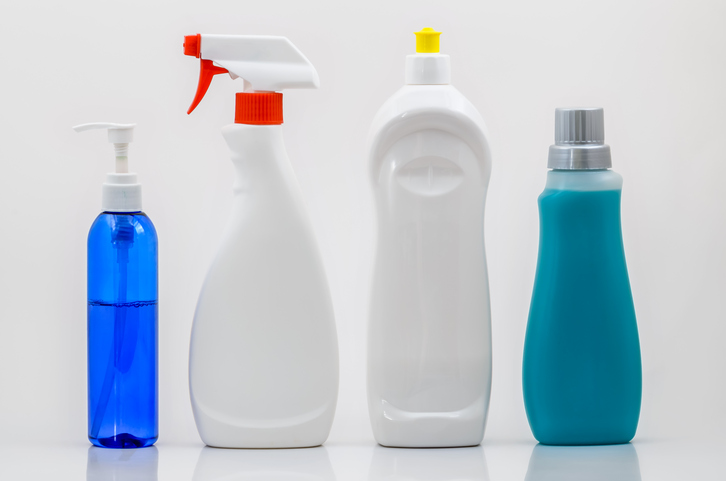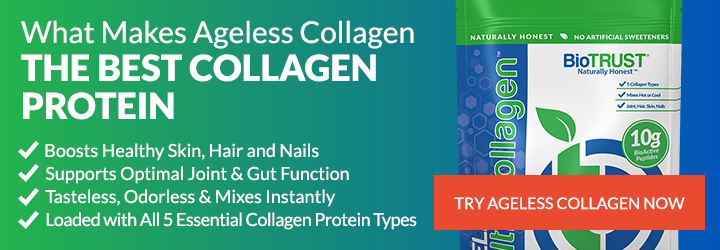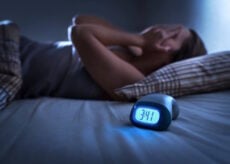Ditch These 9 Dangerous Household Products Immediately

Recently, you may have read such sensational headlines as “Impact of Cleaning Products on Women’s Lungs as Damaging as 20-a-Day Cigarette Habit: Study” (Newsweek) or “Cleaning Products as Bad for Lungs as Smoking 20 Cigarettes a Day, Scientists Warn” (Independent). This probably left you wondering, “Are household cleaning products really that dangerous? I use these every day!” or “How can I keep my house clean AND avoid these dangerous household products?”
These articles are referring to the recent 20-year-long study from Norway that found that chemical cleaning products could be as harmful to lung function as smoking a pack of cigarettes every day for 10 – 20 years. This was a large study with over 6,000 participants, and it found that occupational cleaners (such as housekeepers) experienced a 17% reduced lung function. Even women who regularly use these types of cleaning products at home had a 14% function decline over those 20 years, leading to a much greater risk for chronic obstructive pulmonary disease including chronic bronchitis and emphysema.
The next logical question then is, “What can I use instead?”
We went through our cabinets, checked under our sinks, sorted through our laundry rooms, and scoured the cleaning supplies to find the most likely culprits and provide you with a list of the 9 most dangerous household products. Even better, we found some great options that are less harmful yet work just as well (if not better), so you can enjoy a clean home and breathe easy at the same time.
9 Dangerous Household Products You Use Every Day (and what to use instead)
1. Surface Solvents
You want to keep your house clean, free of sickness-causing germs, and smelling fresh, yet some popular cleaning products are loaded with potentially toxic ingredients. The solvent 2-butoxyethanol, for example, may clean your grimy surfaces, yet it can also be absorbed through the skin and has been shown to damage red blood cells and irritate the eyes. Others contain nonylphenol ethoxylate, which breaks down to nonylphenol, a compound known as an “endocrine disruptor,” meaning it can negatively affect hormones. Other solvents like DEGBE (or, butoxydiglycol) may cause lung inflammation and negatively affect respiration. Others contain “quatemary ammonium compounds” or ethanolamine, which have been shown to cause asthma attacks and may even increase the chances of developing asthma.
What to use instead: You can save cash and stay away from chemicals easily by making your own surface cleaner with just four ingredients. Combine a cup of distilled water with a cup of white vinegar. Then add 20 drops of lemon essential oil and 20 drops of tea tree essential oil (or your choice of other essential oils) in a spray bottle. Shake and spray on any surface. This stores well in a cool, dark space (e.g., under the sink). Just shake well before use each time. If you don’t want to make your own, you can find safer store-bought options from brands like Seventh Generation, Method, Honest Company, and Mrs. Meyers Clean Day.
2. High-Strength Clog Removers
It’s frustrating to have a clogged drain, so you may have found yourself reaching for professional-strength clog removers. Unfortunately, they can create “extreme hazards.” They tend to linger in the drain after use and using a plunger can cause them to splash back onto users. In addition, when combined with other products, they can trigger dangerous chemical reactions. Warning labels are required, but when fighting a clog, you may skim over or ignore the dangers, which can include severe burns, blindness, and even death. Definitely don’t leave these products under sinks where children may get a hold of them.
What to use instead: Sorry, this isn’t a fun one but might be all it takes. Don your rubber gloves and dig out any hair and gunk you can get your hands on. Then grab your handy-dandy plunger and go to work. Follow this up by running hot water (boiling, if possible) down the drain. If your clog is minor, you should be good. Still clogged? Try baking soda and vinegar (or lemon juice) followed by 2 cups of hot water after 15 minutes. Or, mix ¼ cup salt with ¼ cup borax and a ½ cup of vinegar. Again, follow this up with plenty of hot water. Still clogged? If you have a plumber’s snake, you can give that a try. If not, it’s probably time to call a plumber.
3. Oven Cleaners
You’ll often find oven cleaners proudly proclaiming to be “fume-free.” Unfortunately, that does not mean “vapor-free.” And most of these products recommend opening windows and doors to ensure fresh air during use for a good reason: They may cause lung damage and worse (this is one of the most dangerous household products).
What to use instead: Want an easy way to clean your oven without the toxic air? Spread a liberal layer of baking soda into your oven, spray it with water, and let it dry. After 8 hours, scrap off the baking soda and then wipe down your oven with water or a bit of diluted vinegar. A good dose of prevention can work even better. Just keep a cookie sheet on the bottom rack of your oven whenever you cook anything that’s likely to spill over, so you can more easily clean up any drips and drops.
4. Air Fresheners
While we want our homes to smell clean, it’s even better for them to actually be clean. The Environmental Working Group (EWG) found that one well-known air freshener released 89 different air contaminants when tested for air pollution. After reviewing 2,000 different cleaning products, the EWG found 53% contain ingredients that are harmful to the lungs and 22% that contain chemicals that can cause asthma, even in healthy folks. Yikes!
One of the culprits is phthalates, which are found in not only air fresheners but dish soap and even toilet paper. You likely won’t find that word on the label, so the word to watch for is “fragrance,” as that indicates the product likely contains phthalates. Yet, these chemicals are known as endocrine disruptors, and studies have found they can reduce sperm counts. They’ve also been linked to increases in persistent allergic reactions in children. NOTE: Seeing fragrance on a label is usually a pretty good indicator that is one of the dangerous household products
What to use instead: Go with fragrance-free or all-natural organic products. And if you want your air to smell clean and fresh, just open your windows. Looking for a scent you like? Diffuse high-quality essential oils instead. You can also make your own air freshener spray by combining ½ cup of water with ½ cup alcohol (vodka works surprisingly well) and 15 to 25 drops of your choice of essential oil. From citrus to cinnamon to peppermint to all types of combinations, you can find a soothing or refreshing scent without toxic effects.
5. Laundry Detergent
Ahh, there’s nothing like the smell of fresh, clean laundry. Unfortunately, some brands of laundry detergent contain formaldehyde (the same stuff used to preserve dead bodies), which is a known carcinogen that can also lead to asthma and allergies. However, it’s not always claimed as an ingredient on the label, so you may not know what’s in the brand you use.
What to use instead: There are a number of detergents available that don’t include a long list of unpronounceable and potentially toxic ingredients. These include Zum Clean Aromatherapy Laundry Soup, Method Laundry Detergent, Emma Laundry Soap by Eco-Me, Seventh Generation 4X Laundry Detergent, Mrs. Meyer’s Laundry Detergent, The Honest Company Free and Clear Laundry Detergent, and Ecover Laundry Liquid. Of course, there are other brands to choose from, and you can also make your own.
6. Antibacterial Dish Detergents, Hand Soaps, and Hand Sanitizers
Especially when kids are younger, or when you’re being careful to avoid any sickness yourself because you’re already feeling rundown, you may proclaim all-out germ warfare—that is, a war against all germs. Unfortunately, some of the common antibacterial agents, such as Triclosan and quarternary ammonium compounds (or QUATS), are believed to promote the growth of bacteria that is drug resistant and thus harder to fight if you do get ill. What’s more, the American Medical Association hasn’t found any evidence that these types of products make us safer or healthier, and they’re currently being checked out by the Environmental Protection Agency (EPA) to see if they also disrupt hormonal function. If that’s not enough, these chemicals have found their way into our rivers and streams where they are toxic to the naturally growing algae, which can throw off the ecosystem.
What to use instead: Look for detergents and soaps that have a short list of ingredients and avoid using antibacterial products in your home. And if you use hand sanitizers, look for those without Triclosan. Young Living Thieves Hand Sanitizer is a good one, as are Dr. Bronner’s Organic Lavender Sanitizer and EO Botanical Hand Sanitizer. You can also make your own at home in about 3 minutes. Just mix 3 tablespoons of aloe vera gel with 1 tablespoon of filtered water. Then add 5 drops of your favorite essential oil (Thieves, orange, and tea tree oil are all good options). Mix your ingredients in a squeeze bottle to take with you. As a bonus, this solution isn’t drying and doesn’t have that overpowering alcohol scent.
7. Fabric Softeners
I love soft clothing as much as the next person. Unfortunately, QUATS are also a common ingredient in many fabric softeners—both liquids and sheets—so they come with the same potential issues mentioned above. They’ve also been shown to irritate skin, which is the opposite of what you’re hoping for from softer clothing.
What to use instead: White vinegar! This simple product works just as well for removing static and softening fabrics. And if you want to add a nice scent, choose your favorite essential oil and add it to the vinegar for the rinse cycle.
8. Window Cleaners
With several dogs in our home, we often have to clear the canvas (i.e., windows) of the nose artwork. Yet, common window cleaners contain ingredients like 2-butoxyethanol, which belongs to a category of cleaners known as “glycol ethers.” These powerful solvents may cause sore throats if inhaled, and high levels may lead to a higher risk of narcosis, pulmonary edema, and liver and kidney damage. That’s something we don’t want to mess with—ourselves or our dogs. Another common ingredient is ammonia, but we can’t stand the smell. Plus, it’s a strong irritant, and it’s been found to cause chronic bronchitis and asthma with excessive exposure (with the housekeepers mentioned in the study above, for example).
What to use instead: Because of the tenacity of the nose artwork, we’ve tried a number of products and have two top picks. Believe it or not, straight water and a microfiber clothe work remarkably well. Alternatively, club soda—yes, club soda—works just as well on mirrors. Bonus, it’s odorless, it’s cheap, and it’s easy to find (plus, you can rest assured knowing you are avoiding one of the dangerous household products).
9. Bleach
You may think that if you want to get your clothes white and kill all germs, bleach is your only option. Yet, bleach isn’t just deadly when mixed with ammonia, it may be a serious thyroid disrupter. Unfortunately, you’re constantly exposed to bleach when you use commercial scouring powders, mildew removers, and laundry whiteners—not to mention tap water (as chlorine bleach is added to water to kill bacteria).
What to use instead: If you’re scrubbing your countertop or sink, use baking soda. Want to whiten your clothes? Try vinegar or borax powder (or both) or add one cup of diluted hydrogen peroxide, which whitens, disinfects, and deodorizes. (Remember to use it only on whites as it will bleach your colors and darks). Lemon and sunshine are also well-known whiteners. Or, look for chlorine-free oxygen “bleaches” as an alternative.
Some sources claim a combination of vinegar and hydrogen peroxide are both gentler and more effective than bleach for disinfecting. Rather than mixing the two liquids together, first spray the surface with vinegar followed by a 3% hydrogen peroxide solution and then simply wipe it down.
9 Dangerous Household Products to Avoid: A Recap
Cleaning becomes more enjoyable when you use products you’re not using these 9 dangerous household products, and you can get your home just as clean (or likely much more so) with the use of fewer toxic ingredients. Give some of these options a go to see if you don’t agree that your home looks better, smells better, and stays cleaner without the toxic chemical load.







